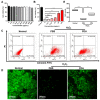A Melanin-like Nanoenzyme for Acute Lung Injury Therapy via Suppressing Oxidative and Endoplasmic Reticulum Stress Response
- PMID: 34834263
- PMCID: PMC8622162
- DOI: 10.3390/pharmaceutics13111850
A Melanin-like Nanoenzyme for Acute Lung Injury Therapy via Suppressing Oxidative and Endoplasmic Reticulum Stress Response
Abstract
Nanoenzyme-mediated catalytic activity is emerging as a novel strategy for reactive oxygen species (ROS) scavenging in acute lung injury (ALI) treatment. However, one of the main hurdles for these metal-containing nanoenzymes is their potential toxicity and single therapeutic mechanism. Herein, we uncovered a melanin-like nanoparticles derived from the self-polymerization of 1,8-dihydroxynaphthalene (PDH nanoparticles), showing a significant anti-inflammation therapeutic effect on ALI mice. The prepared PDH nanoparticles rich in phenol groups could not only act as radical scavengers to alleviate oxidative stress but could also chelate calcium overload to suppress the endoplasmic reticulum stress response. As revealed by the therapeutic effect in vivo, PDH nanoparticles significantly prohibited neutrophil infiltration and the secretion of proinflammatory cytokines (TNF-α and IL-6), thus improving the inflammatory cascade in the ALI model. Above all, our work provides an effective anti-inflammatory nanoplatform by using the inherent capability of melanin-like nanoenzymes, proposing the potential application prospects of these melanin-like nanoparticles for acute inflammation-induced injury treatment.
Keywords: 1,8-DHN polymerized nanoparticles; acute lung injury; endoplasmic reticulum stress; melanin-like nanoenzyme; oxidative stress.
Conflict of interest statement
All authors declare no financial/commercial conflict of interest.
Figures





Similar articles
-
Polydopamine nanoparticles for the treatment of acute inflammation-induced injury.Nanoscale. 2018 Apr 19;10(15):6981-6991. doi: 10.1039/c8nr00838h. Nanoscale. 2018. PMID: 29610822
-
An auto-photoacoustic melanin-based drug delivery nano-platform for self-monitoring of acute kidney injury therapy via a triple-collaborative strategy.Acta Biomater. 2022 Jul 15;147:327-341. doi: 10.1016/j.actbio.2022.05.034. Epub 2022 May 25. Acta Biomater. 2022. PMID: 35643195
-
CRBN knockdown mitigates lipopolysaccharide-induced acute lung injury by suppression of oxidative stress and endoplasmic reticulum (ER) stress associated NF-κB signaling.Biomed Pharmacother. 2020 Mar;123:109761. doi: 10.1016/j.biopha.2019.109761. Epub 2019 Dec 19. Biomed Pharmacother. 2020. PMID: 31865141
-
A Melanin-Based Natural Antioxidant Defense Nanosystem for Theranostic Application in Acute Kidney Injury.Adv Funct Mater. 2019 Nov 28;29(48):10.1002/adfm.201904833. doi: 10.1002/adfm.201904833. Epub 2019 Sep 25. Adv Funct Mater. 2019. PMID: 32055240 Free PMC article.
-
Melanin/melanin-like nanoparticles: As a naturally active platform for imaging-guided disease therapy.Mater Today Bio. 2023 Dec 5;23:100894. doi: 10.1016/j.mtbio.2023.100894. eCollection 2023 Dec. Mater Today Bio. 2023. PMID: 38161509 Free PMC article. Review.
Cited by
-
4-Octyl itaconate alleviates endothelial cell inflammation and barrier dysfunction in LPS-induced sepsis via modulating TLR4/MAPK/NF-κB signaling : 4-Octyl itaconate alleviates endothelial dysfunction.Mol Med. 2025 Jun 16;31(1):240. doi: 10.1186/s10020-025-01160-2. Mol Med. 2025. PMID: 40524158 Free PMC article.
-
The RhoB p.S73F mutation leads to cerebral palsy through dysregulation of lipid homeostasis.EMBO Mol Med. 2024 Sep;16(9):2002-2023. doi: 10.1038/s44321-024-00113-2. Epub 2024 Jul 30. EMBO Mol Med. 2024. PMID: 39080495 Free PMC article.
-
Significance of the gut tract in the therapeutic mechanisms of polydopamine for acute cerebral infarction: neuro-immune interaction through the gut-brain axis.Front Cell Infect Microbiol. 2025 Mar 4;14:1413018. doi: 10.3389/fcimb.2024.1413018. eCollection 2024. Front Cell Infect Microbiol. 2025. PMID: 40104260 Free PMC article.
-
Melanin nanoparticles enhance the neuroprotection of mesenchymal stem cells against hypoxic-ischemic injury by inhibiting apoptosis and upregulating antioxidant defense.Cell Biol Int. 2022 Jun;46(6):933-946. doi: 10.1002/cbin.11781. Epub 2022 Feb 22. Cell Biol Int. 2022. PMID: 35170135 Free PMC article.
-
Multifunctionally disordered TiO2 nanoneedles prevent periprosthetic infection and enhance osteointegration by killing bacteria and modulating the osteoimmune microenvironment.Theranostics. 2024 Sep 16;14(15):6016-6035. doi: 10.7150/thno.98219. eCollection 2024. Theranostics. 2024. PMID: 39346538 Free PMC article.
References
-
- Chacko B., Peter J.V., Tharyan P., John G., Jeyaseelan L. Pressure-controlled versus volume-controlled ventilation for acute respiratory failure due to acute lung injury (ALI) or acute respiratory distress syndrome (ARDS) Cochrane Database Syst. Rev. 2015;1:CD008807. doi: 10.1002/14651858.CD008807.pub2. - DOI - PMC - PubMed
Grants and funding
LinkOut - more resources
Full Text Sources
Research Materials

